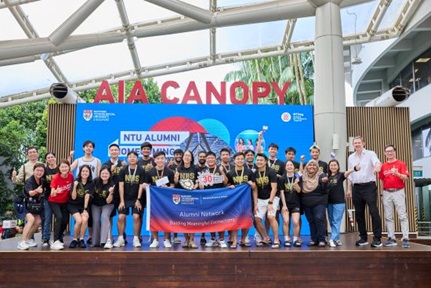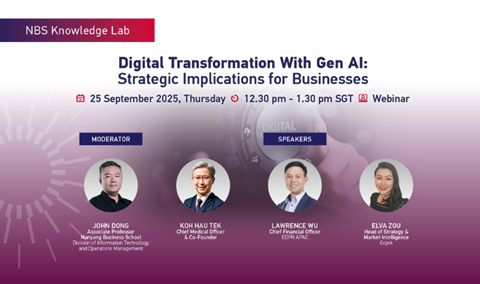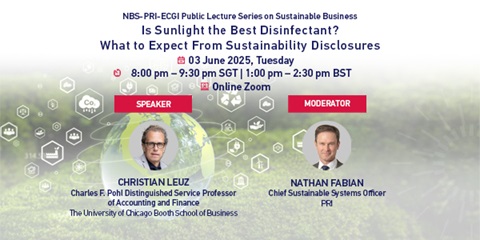NBS Knowledge Lab Webinar: Climate Change - From Risk to Resilience
In this webinar, we bring together experts who attended COP27 in Egypt to reflect on the progress made during the event and the path ahead.
The UN facilitated COP27 concluded in Egypt in November 2022 with a landmark agreement to set up a loss and damage fund to compensate developing countries that suffered natural catastrophes due to climate change induced by emissions. However, it remains uncertain if the fund will be adequately funded.
In this timely NBS Knowledge Lab webinar, we brought together expert panellists Fam Wee Wei, Director (Climate Change and Sustainability—International) Industry Division, Ministry of Trade and Industry, Singapore, Dr Ayansina Ayanlade, University Assistant in the Department of Geography and Regional Research, University of Vienna, Austria (both speakers attended the COP 27) and Michèle Lacroix, Group Head of Sustainability of SCOR along with our moderator Amit Jain, Director of the NTU-SBF Centre for African Studies to reflect on the progress made during the summit and the path ahead. Below is the edited version of the transcription with some of the key takeaways. You can watch the full recording here.
Fam Wee Wei on COP27 and Singapore’s ‘Green Opportunities’
The common understanding of COP27 is about the UNF Triple-C negotiations. The loss and damage fund set out was a significant outcome of COP27. But besides the UNF Triple C negotiations, which happen on the multilateral front, there is a bilateral negotiation that complements it.
This year, Singapore launched the inaugural Singapore pavilion for business activities, panel discussions, and networking sessions. Three tracks of work go on at the Conference of Parties (COP), and it has grown organically over the years because of the work that has grown in the climate change and sustainability space. For those who are aware, each year, the COP convenes to discuss climate change issues such as mitigation, voluntary cooperation on Article 6, negotiations, adaptation and loss of damage, finance, and technology agenda.
For bilateral negotiations, the outcomes of COP26 at Glasgow have helped firm up the Paris rulebook. Therefore, parties have started going about collaborations on carbon credits that are aligned with Article 6. This will be a key part of my work - driving bilateral cooperation with other countries to allow for the international transfer of litigation outcomes.
The key outcome of COP 27 for us is the loss and damage fund. Many would say that the outcomes are rather thin, compared to some of the other COPs, because of the focus on implementation. The establishment of the water damage fund was regarded as the most significant outcome of COP 27. Essentially, we see COP 27 teamed up with next year's COP 28, which the UAE is hosting, to deliver more substantive outcomes and close the gap in ambition across mitigation, adaptation, and finance, particularly with the final phase of the global stocktake taking place at the end of 2023. The loss and damage fund is a hard-won victory for developing countries. We have been calling for such a fund for years, but it was not without compromise. Therefore, a transitional committee was set up to make recommendations on how to operationalize the fund and on the funding arrangements that will be set up for consideration at COP 28 next year. So, there are high expectations for COP 28 on loss and damage, and all eyes will be on this transitional committee, and how it will help to advance work on the so-called L&D fund.
For Singapore, we have been particularly looking at Article 6 cooperation. We have signed MOUs with countries such as Morocco, Vietnam, and Colombia, amongst others. On the sidelines of COP 27, we signed MOUs with Papa New Guinea, and this is the start of a lot of other MOUs we will probably sign with other countries. Singapore is not the only country that is looking at Article 6 cooperation. Other countries like Switzerland, Korea, Japan, and Sweden are running fast on this front. I think it was Switzerland and Ghana who issued the first Article 6 compliance or carbon credits on the sidelines of COP 27. This is something significant for the carbon credits market as this means that these credits are not double counted. In my understanding, even in the voluntary market, corporates are looking at such credits, which are deemed of higher quality. So, on the bilateral front, I think there are some significant outcomes that companies are watching for.
Other significant COP announcements include a closing-in on greenwashing activities, with UN High-Level expert groups like ISO and CDP releasing standards and guidelines for companies to take reference regarding net zero commitments. I think, gradually, the room for greenwashing will be reduced because of all the standards that have been set up. We also see countries making announcements to join initiatives to show their commitment to climate action.
On the countries' front, there are things like net zero initiatives being rolled out and also a first mobile coalition that countries have been joining to push for the acceleration of the development of things like low-carbon technologies. The implication of some of these developments from the climate funding perspective, in my personal view, is that the loss and damage fund is unlikely to affect the private sector. But climate finance, overall, is still something that countries are trying to address. In my opinion, the private sector is an untapped source; there could be a possibility of looking at the private sector to provide some sort of blended finance to investigate the climate finance funding gap.
On the carbon markets, there is a broad acceleration of efforts, and my assessment is that we can potentially see the appearance of corresponding adjustment carbon credits in the market as early as next year or even 2024, given how fast countries are moving on Article 6.2. Last but not the least, I think there is much drive and push to restore trust in corporate climate commitments like net zero commitments, with one or more international bodies rallying around standards they've been trying to advocate for companies to adopt. I think this also gives companies more confidence as they go about the sustainability journey, including the buying of carbon offsets.
Now, about climate targets. In terms of the increase in carbon taxes in Singapore, we raised our climate ambition in October, and the ambition is to achieve net zero emissions by 2050. I would say that coming from the Ministry of Trade and Industry, this is an ambitious target that Singapore has put up, and there is much work that is cut out for us. Our NDC was also revised, and we are one of the 20 countries that strengthened our NDCs. We have committed to reducing 2030’s emission target to 60 million tonnes of CO2 equivalent after peaking emissions earlier. We do see the carbon taxes increase as a key enabler to achieving some of these targets that we have set up, as it sends a clear signal to the market that we are accelerating decarbonisation efforts. The other thing I would like to highlight about how we have set out our carbon taxes is that we will allow companies to offset 5% of their carbon tax liabilities using high-quality international carbon credits. We see this as a move that will also help to capitalize on the carbon markets.
Finally, how are we accelerating our low carbon transition and the potential "green opportunities" that can be reaped from what Singapore is trying to do as we move towards greater sustainability? To move towards greater sustainability, I think there's a general recognition of a trend by companies that they need to be part of a sustainable supply chain, and that this leads to an increase in demand for services such as carbon foot printing, or carbon profiling, consultancy services on emission reduction and demand for energy-efficient equipment. So, in a bid to meet all these corporate net zero targets, we do see that there will be a demand for all these services. On top of that, there will be a demand for voluntary carbon credits in the market to offset or inset some of the EU emissions that are hard to abate.
Moving on, I would like to highlight that carbon capture storage (CCS) is a key decarbonisation pathway for Singapore, and we can expect that technologies related to CCS will go up. Hydrogen is a nascent area, but we have just announced the hydrogen strategy recently on the side lines of the Singapore International Energy week, and we see ourselves playing the role of a hydrogen hub soon. So, this is something that bears watching.
I would also like to put our focus on the fact that Singapore is building up as a carbon service and trading hub. We have been putting in place various infrastructures, and we can expect more jobs to be created in this space. Last month, we announced the setting up of the World Bank's “CAT Trust”, formerly known as the climate warehouse, where a more transparent system for credits can be stored in a central registry created to avoid double counting of credits. These are some of the key enabling infrastructures that we have been trying to put in place to promote or develop a more robust carbon market so that companies will have confidence in buying some of these carbon credits. I currently think there is some fear among companies that they could be seen as greenwashing when they go into the carbon markets. So, these are some key enabling infrastructures we have been putting in place to help support the growth of the carbon services and trading hub.
I would also say that Singapore has been advocating for low-carbon practices. In particular, electric vehicles will take off in a big way. People will also have to transition from traditional roles. For example, in the electric vehicle market, car mechanics will have to learn how to maintain and repair EVs as the electric vehicle market grows and becomes more viable for regular consumers in Singapore. These are some of the "green opportunities" out there that businesses can look out for as we transition into a greener economy.
Dr Ayansina Ayanlade on the effects of climate change in Africa
This section will focus on the loss and damage fund, specific case studies from Africa and Nigeria and some parts of East Africa, where we can see the effects of extreme events that lead to loss and damage. ‘Loss and damage’ is seen as an observed impact of projected risk that can have economic and non-economic implications in any country, community or individual. All these are manifested globally and, specifically, in Africa in terms of droughts, floods and sea level rise. These extreme events from climate change led to loss and damage in Africa. A recent flood in Nigeria this year led to the deaths of over 600 people and the displacement of about 1.4 million. Besides that, extreme events have both direct and unintended consequences for people. All these are very important and part of what was discussed in terms of global events, and loss and damage in COP 27.
Another case example is drought in East Africa. Usually, extreme events include either too little rainfall, which leads to droughts or prolonged drought spells like what is going on in East Africa, or too much precipitation, which leads to floods like what we see in many parts of West African countries, and even in South Africa. Currently, in East Africa, many pastoralists could not feed their animals. They had to travel long distances, moving from one country to another. This is an example of extreme events leading to loss and damage; death of animals, and farmers losing their livelihood. Millions of people are currently malnourished and displaced in East Africa. Because of the drought, they do not have enough food and water. In my own research in Nigeria, working with rural communities, most rural communities have experienced the impact of extreme events in terms of their farms and livelihoods. All these will have implications on people, what they do, and what they eat. It will also affect their mobility; some people will leave their community as a result of floods, and many may not be able to return. Some people will take years before they can even recover from the loss and damage that they experienced because of the flood.
And what is the implication of climate change on commodity markets, especially for emerging markets like Nigeria and the majority of African countries? Climate-related events have a significant impact in terms of commodity prices. We can see the rate of increase in terms of the price of goods in East Africa; most of the crops usually produced cannot live because of the drought. Having said that, separating agriculture and raw material resources, is extremely vulnerable to the effects of climate change. This has implications for emerging markets and businesses in Africa. The discussion from COP 27 has been related to how we need to keep the global average temperature rise below 1.5. This is very, very important to limit future loss and damage.
Another thing which is also very important, especially for the African continent, is climate finance, which we will talk about in terms of carbon credits. There is a need for robust climate finance, and we are very happy that, after COP27, we have reached an agreement about the loss and damage fund. But it is important to work around it to make this fund available, especially for the African continent. Importantly, how can we make finance available for rural communities for them to adapt and, more importantly, create a business? Additionally, there are technologies available in developed countries that Africa needs in order to cope and adapt to loss and damage from climate change. All these need to be put in place to afford Africa’s fiscal scenario.
Michèle Lacroix on blended finance and climate change
I will be talking about what SCOR is doing in terms of climate change and what it means for us. SCOR is a tier-one reinsurer. The role of the venturer is to ensure insurers, who transfer excess risks they don’t want to take. The insurance industry is exposed to climate change as a lot of others are, but its specificity is to be exposed on both sides of the balance sheet. As insurers, we suffer from increased frequency and severity of weather-related events. We are also exposed to transition risks, as some activities like fossil energies, for instance, will likely decrease in the coming years. This will put our income at stake. As investors, we are also exposed to the risk of loss of value of our investments as a consequence of the transition to a low carbon economy but also to physical risks. For instance, property damages and business interruption.
If we come back to the title of the panel, “from risk to resilience”, I would like to spend a couple of minutes on the double materiality principle. Climate change can be seen from two lenses. Climate change can have impacts on the value of our portfolios due to physical risks. What if, for instance, the building we have invested in is close to the coast and the sea level rises? Transition risk as well - what if regulation increases the price of the carbon tax? What will be the value of investments in high-emitting sectors? This is what is called the "Outside In" effect of climate change. But another view is as important as resilience. It is the impact of business models and external ecosystems and how investors can influence the environment by taking investment decisions that limit adverse impacts or even have a positive impact on the environment. Funding reforestation, for instance. It is what is called the "Inside Out" effect. Resilience is usually measured as a way to protect financial capital - let us say the impact on protecting natural and social capitals. However, there is a strong interconnectedness between the two and we need to consider both, especially as insurers. When trying to limit greenhouse gas (GHG) emissions now, we can protect our core business of protecting against natural catastrophes in the long run. And there is this loopback effect that we need to consider.
Many investors have committed to becoming net zero by 2050, but how does this tie in with resilience? When trying to foster the transition to a low-carbon economy and the decarbonisation of our portfolio, we intend to go further than only protecting the value of our assets. We intend to reduce GHG emissions in the atmosphere, which can be done by combining three actions.- One is, of course, reducing the GHG emissions of our investment portfolio.
- Second, and probably the most powerful, is to engage with industries and support them in their transition.
- Lastly, finance the transition to a low-carbon economy, especially where it is most needed.
Key Takeaways
Singapore’s collaboration with African countries
Financing the African continent
The world simply has not come to grips with how much money it is going to need to assist developing countries with what is coming. We only saw in October how $33 billion was lost by Pakistan as a third of the country was immersed in water. We are talking about the loss and damage fund, which is no more than $400 billion. The UN estimates it could run into trillions and trillions of dollars, and so what it means is that we need the developing finance institutions coming together to help unlock private capital. In a city like Singapore, looking at the assets under management that is done by the financial sector here, alone runs up to over $4 trillion. When countries like France and Singapore go out to the market to get finance, they get it at a 1-2% rate of interest. When African countries go, they have to pay six times that interest. These are some critical issues that need to be addressed before financing can really be made available.
Blended finance
SCOR believes that the efforts of the community of the Net Zero Asset Owner Alliance can make a difference. SCOR has worked very hard to put in place this platform, which is now up and running and is collecting more and more offers from asset managers. This is something that has been developed with the asset managers and with Multilateral Development Banks (MDBs). SCOR is collecting from the MDBs and Development Finance Institutions (DFIs), data that is missing and is organizing data so that it becomes comparable. While it is impossible for a single firm to save or heal the world on its own, it is one additional tool that investors have at their disposal. SCOR will also have to report on how much they invest in this; transparency is key. Having something, which is robust and provides comparability is also part of the triggers used by investors to overcome this risk. It is not that it is riskier to invest in developing countries, it is really that insurers do not have the data. Insurers need to have something that they can rely on to assess how much they can allocate to these types of risks. And with the MDBs and DFIs taking the first losses through blended finance, it becomes closer and closer to investors’ risk budget and the risks they are allowed to take.
Watch the webinar here:







